
By Brynn Hooton-Kaufman, Phycology Lab
I went to bed last night with plans to wake up and go snorkeling in Stillwater Cove at 8 am this morning. You might say those plans changed a bit when I got a phone call from my brother at 1:45 am. Well, actually it was five phone calls, because it took me that long to shake off the cobwebs of sleep and realize he wasn’t pocket dialing me. My thoughtful brother was up watching television, and had been alerted by the news to the disaster that had taken place in Japan. He called to let me know that a tsunami was headed toward the west coast with an arrival time of approximately 7:30 am, and he was concerned since we are residents of Monterey. Thankfully, we live high on one of the marine terraces in New Monterey, and I assured him that we would be safe from any floodwaters, and headed back to bed.
I immediately flipped on the television when I woke up this morning at 6, and started catching up on the news. The dramatic videos from Japan were chilling, and showed the ocean washing over agricultural land, pouring through city streets, and creating whirlpools that entrapped boats. The effects of the tsunami on Hawaii thankfully looked much milder, and the news didn’t report major damage from the flooding they experienced. As for our tsunami forecast, the news crews were predicting waves of a few feet high to hit around 7:45. I called my snorkeling buddy, updated her on the current events since she hadn’t seen the news, and we both decided that calling off the trip to Stillwater was a good idea.
I continued to watch the news, and when 7:45 rolled around, I was a little surprised not to see any changes on the beaches in the live-feed video. I even started to wonder if canceling the trip to collect seaweeds had been a mistake. But then I reminded myself, better safe than sorry. I don’t want to be the student with poor judgement who thought it was more important to collect materials for an exam than to heed tsunami warnings, and get swept out to sea. Besides, I reminded myself, tsunamis aren’t over in a blink of an eye; they can continue to have an impact for hours.
And it turns out that’s exactly what happened. Pretty soon on the news, boats and docks were getting ripped from their moorings in Santa Cruz harbor, and were barreling into anything in their way. MLML grad student Sara Hutto was high and dry, far from the dangers of the surge, but managed to catch these great photos:
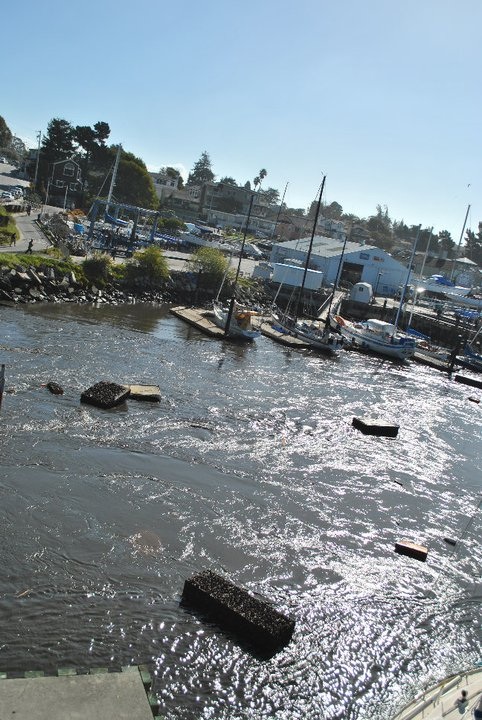
As you can see, the current is moving quickly, and taking pieces of the harbor with it. The tsunami was really interesting to watch. It didn’t just move in once as a big surge, then drain back out, but instead it did this multiple times. It was kind of like watching a dramatic tide cycle, all happening in twenty minutes or so, and then starting all over again. Here’s one way to show you what it was like:
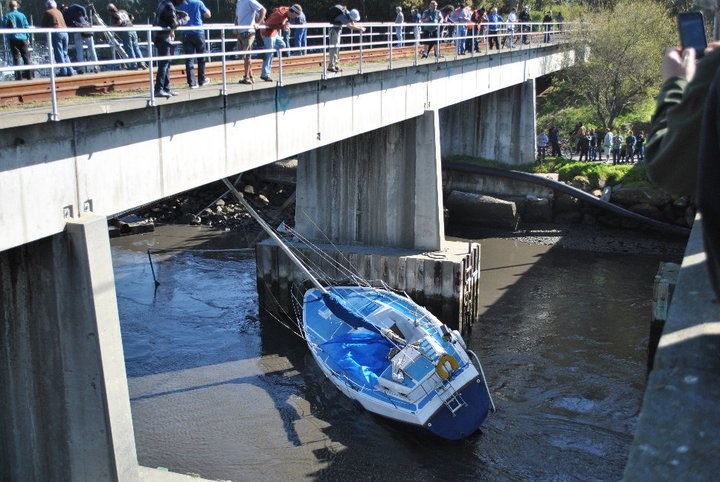
This boat was torn from its moorings by the quick current as the water from one of the tsunami surges receded from the harbor. It got stuck on a mud bar, and it looks like it will be here to stay, until:

Another surge from the tsunami poured back into the harbor and picked the boat back up. Here it’s floating next to some of the other boats that broke loose.
Here are some more pictures Sara took in Santa Cruz:
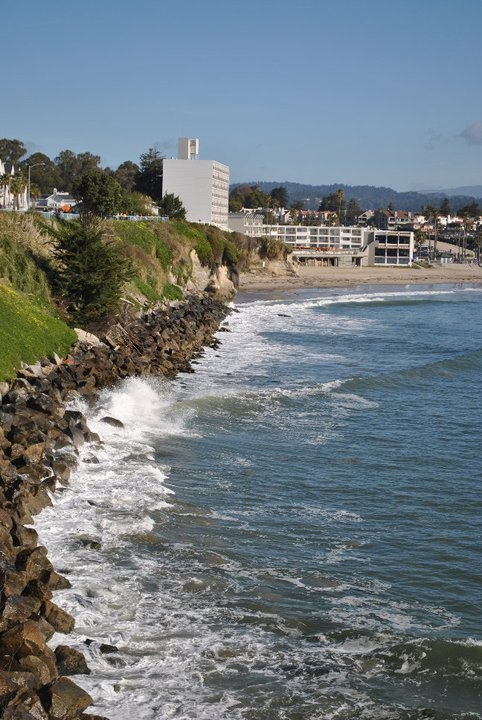
This photo shows the surge from the tsunami breaking along the shore. It might not look like much because it’s low tide, but if you keep watching…

You’ll start to see that the water looks calmer. This photo was taken during the transition from the tsunamis’ surge to the water receding. You’ll see that it rapidly gets more dramatic:
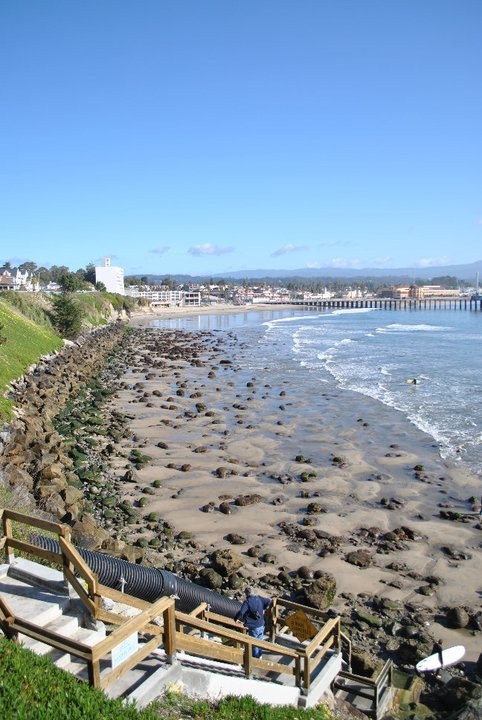
The subtidal boulders are exposed as the water draws back out between the tsunami surges. It’s really impressive how far it sucks out:
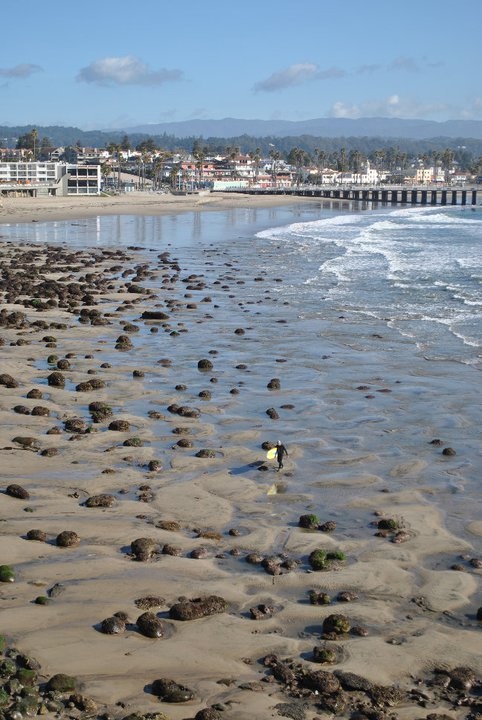
Sara was pretty shocked by how far the water receded, as she’s never seen it get this low even on an incredibly low tide. The surfers in this picture really put it all into scale.
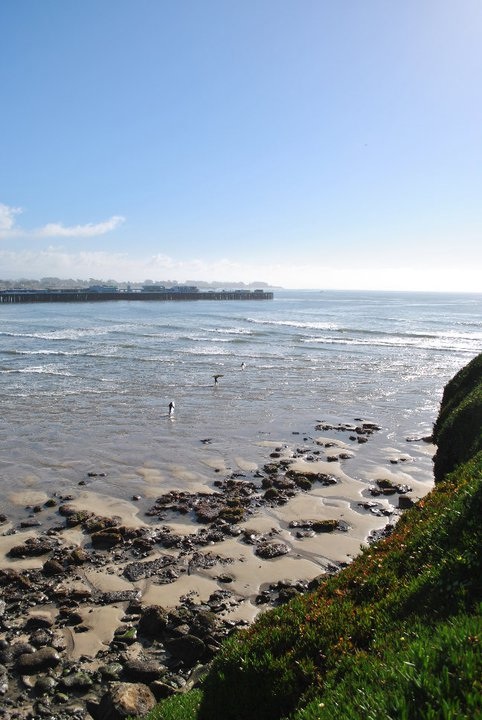
Sara said that usually, these surfers would be hopping in the water from the stairs at the base of this cliff and paddling out, not hiking out to the waves quite a distance offshore.
Now, you must be wondering how we fared at the labs in Moss Landing. Thankfully, we can report that we came away unscathed. We have a wonderful emergency alert system, and calls went out to all students and staff from the MLML Health and Safety Officer around 6:45 this morning, alerting everyone to the possible disaster and asking them not to come in to the labs until further notice. And what did happen in Moss Landing? Those that were here reported that the slough in front of the labs drained, then filled up about 3 feet higher than was normal for the tide, then rapidly drained again as the surge rushed back out. This happened repeatedly, and could also be seen in the harbor. Even though some of our facilities on the sand spit are on much lower ground than the main labs, no tsunami surges breached the land and no flooding occurred. The main lab, up on our hill, was actually used by some of the locals for high ground and refuge from possible tsunami waves.

So, all is well at Moss Landing Marine Labs. I will be venturing out in Stillwater Cove tomorrow morning in another attempt to gather seaweeds to challenge my students on their Biology of Seaweeds midterm. Wish me luck!

